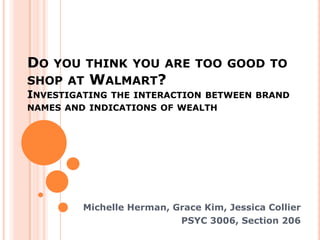Research on shopping group presentation
- 1. DO YOU THINK YOU ARE TOO GOOD TO SHOP AT WALMART? INVESTIGATING THE INTERACTION BETWEEN BRAND NAMES AND INDICATIONS OF WEALTH Michelle Herman, Grace Kim, Jessica Collier PSYC 3006, Section 206
- 2. INTRODUCTION  People make purchase decisions based upon perceptions of wealth and success (Mandel et al., 2006)  Sodas with national brand names are chosen more often than bargain brand names (Breneiser & Allen, 2011; Bushman, 1993)  Past research has not addressed the effect of both status of brand name and indication of wealth on shopping preferences
- 3. HYPOTHESES  The mean difference in favorability ratings between the condition with the wealthier- looking family and average-looking family will be greater in the higher-status brand name (Macy’s) condition than the mean difference in favorability ratings between wealthier-looking family and average-looking family in the lower- status brand name (Wal-Mart) condition  We also predicted that there would be main effects for both brand name status and indication of wealth
- 4. PREDICTED INTERACTION 7 6 5 Favorability 4 Wealthy Family 3 Average-Looking Family 2 1 0 Macy's Wal-Mart Store Brand
- 5. METHOD  Participants  36 participants  10 men, 25 women, and 1 non-response  Design/Materials  2 x 2 between-participants design  Brand name and indication of wealth were manipulated  Four conditions: (1) higher-status brand / higher indication of wealth (2) higher-status brand / lesser indication of wealth (3) lower-status brand / higher indication of wealth (4) lower-status brand / lesser indication of wealth
- 6. METHOD  Interpretation of shopping preferences were measured using 3 items on a questionnaire  7-point Likert Scale  1 = Strongly Disagree and 7 = Strongly agree  Each of the items were averaged to make a composite score  Procedure  Randomly assigned conditions by receiving a packet with one of four conditions  Each participant was instructed to carefully look at the pictures and form an opinion  Then asked to complete the questionnaire on the next page
- 7. MATERIALS Lower-status brand Lower-status brand name/wealthier- name/average-looking looking family family
- 8. MATERIALS Higher-status brand Higher-status brand name/wealthier- name/average-looking looking family family
- 9. SAMPLE MATERIALS  Target Questions  (1) I would be willing to buy items at this store.  (2) I would enjoy shopping at this store.  (3) I would recommend this store to friends and relatives. 1 2 3 4 5 6 7 Strongly Disagree Slightly Neutral Slightly Agree Strongly Disagree Disagree Agree Agree
- 10. RESULTS  We conducted a 2 (Brand Name Status) x 2 (Indication of Wealth) between-participants ANOVA, alpha = .05  Correlations between each of the target questions on the questionnaire (r ≥ .50)  The scores were averaged to produce a composite DV score for each participant  No significant main effect of brand name, F (1, 32) = .02, p = .893  No significant main effect of indication of wealth, F(1, 32) = .10, p = .755  No significant interaction between brand name and indication of wealth, F(1, 32) = .59, p = .450
- 11. MEAN AND SDS IV 1: Brand IV 2: Indication Mean SD Status of Wealth Lower-brand Average-looking 4.59 .62 status family Lower-brand Wealthier- 4.78 1.63 status looking family Higher-brand Average-looking 4.96 1.21 status family Higher-brand Wealthier- 4.52 1.26 status looking family
- 12. DISCUSSION  Presence of wealth and store brand status had no effect on shopping preferences  Findings do not support that people make purchase decisions based upon perceptions of wealth and success (Mandel et al., 2006)  Findings do not support that status of brand name impacts consumer choices (Breneiser & Allen, 2011; Bushman, 1993)
- 13. DISCUSSION  Previous exposure to the brand name might have affected participant’s attitudes towards these name brands  Stimuli might not have accurately portrayed the conditions  Experiment might not have been structured well enough to give participants enough time to develop a strong opinion about the stimuli  Future research should investigate whether pre-existing attitudes towards brand names affect shopping preferences
- 14. REFERENCES Brenesier, J.E. & Allen, S. N. (2011). Taste preference for brand name versus store brand sodas. North American Journal of Psychology, 13(2), 281-290. Bushman, B. J. (1993). What’s in a name? The moderating role of public self-consciousness on the relation between brand label and brand preference. Journal of Applied Psychology, 78(5), 857-861. Mandel, N., Petrova, P. & Cialdini (2006). Images of Success and the Preference for Luxury Brands. Journal of Consumer Psychology, 16(1), 57-69.
Editor's Notes
- Michelle
- Grace














